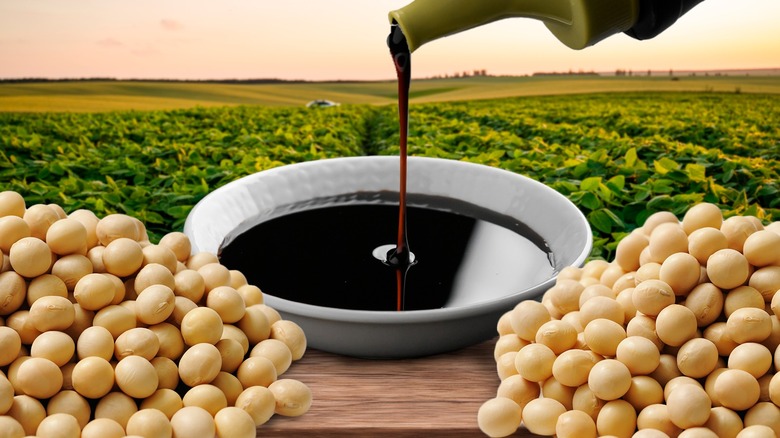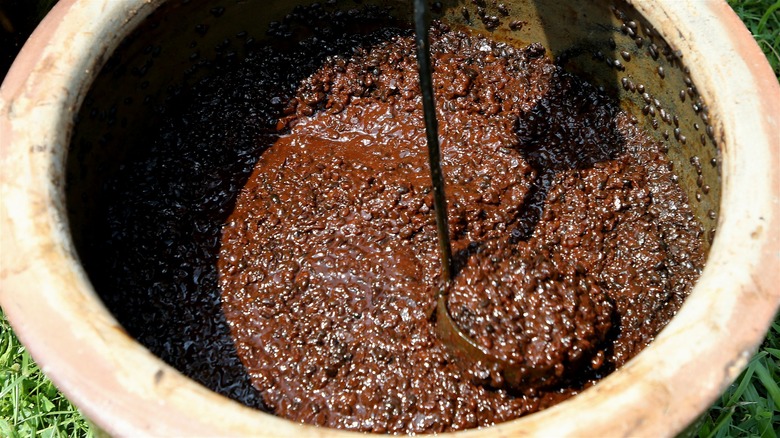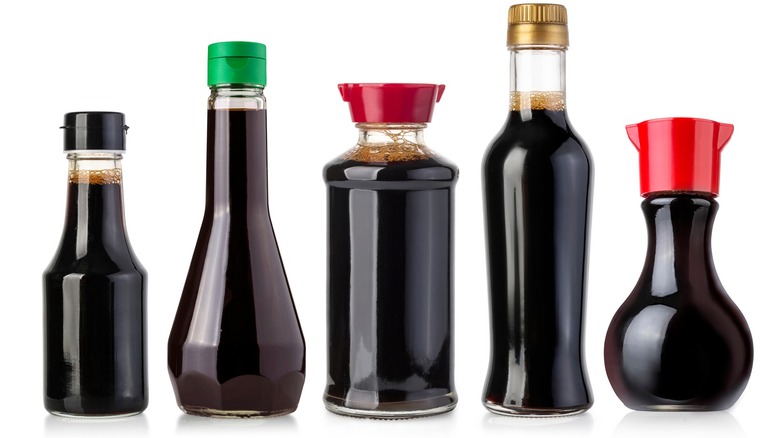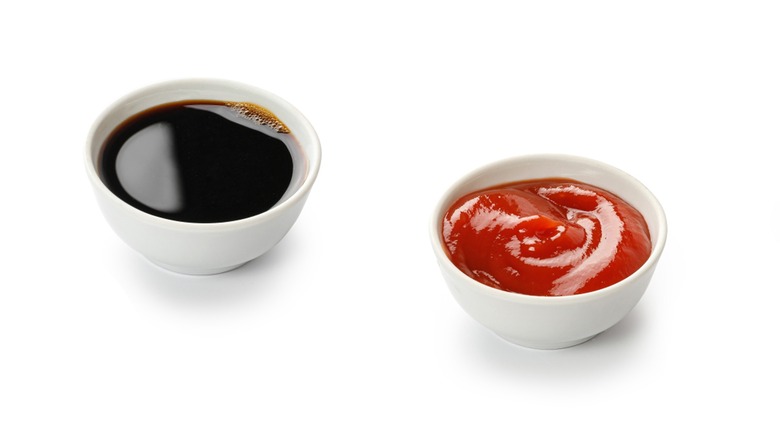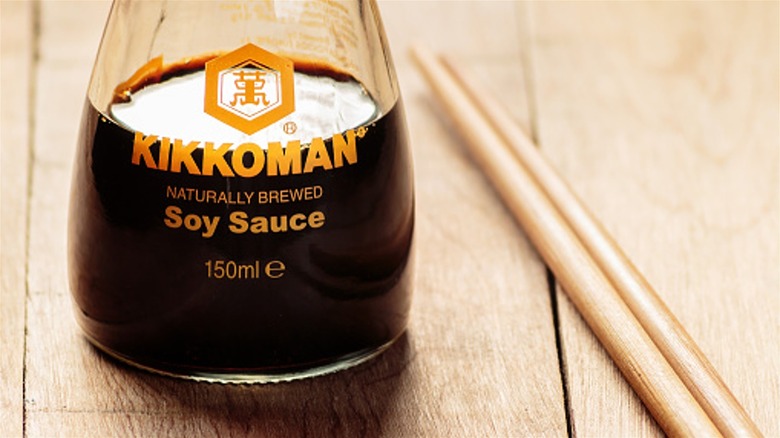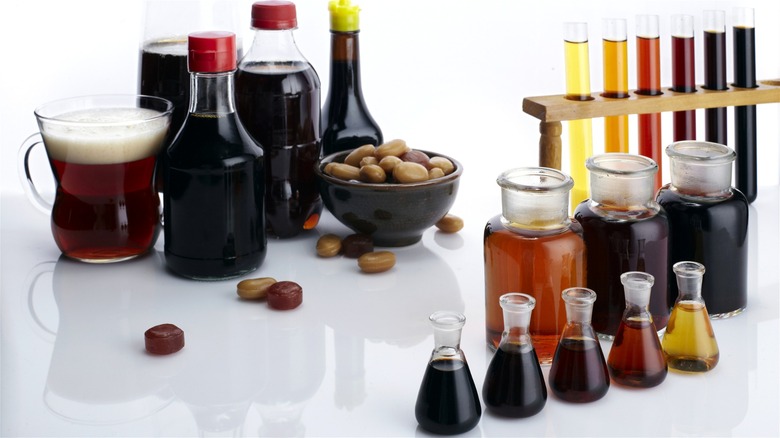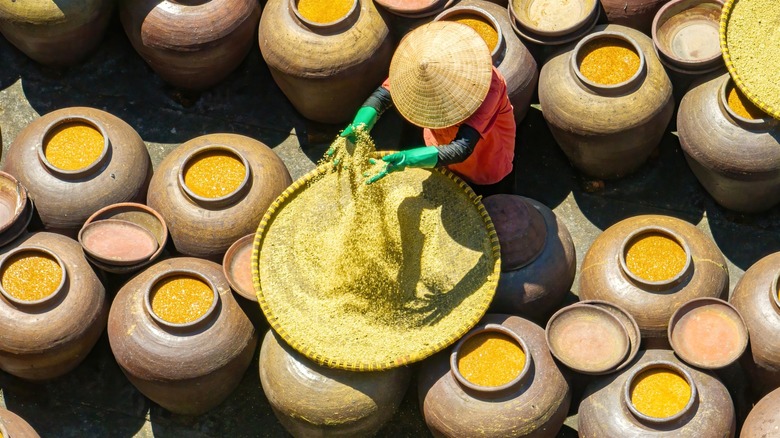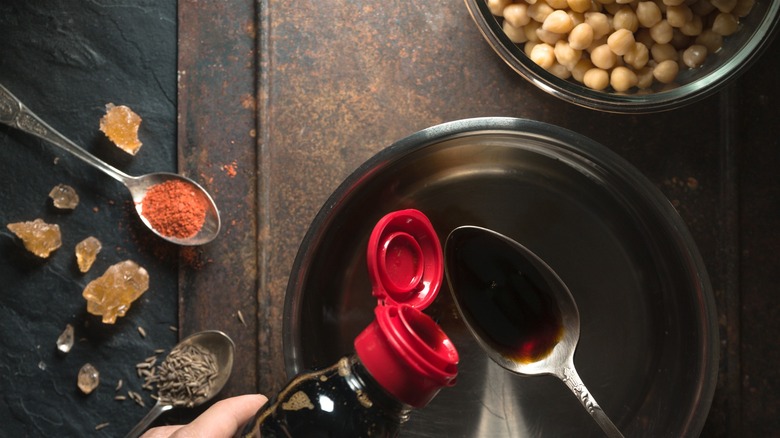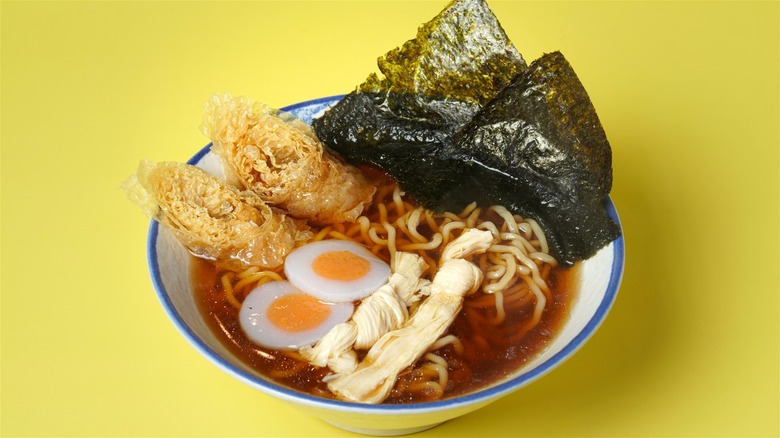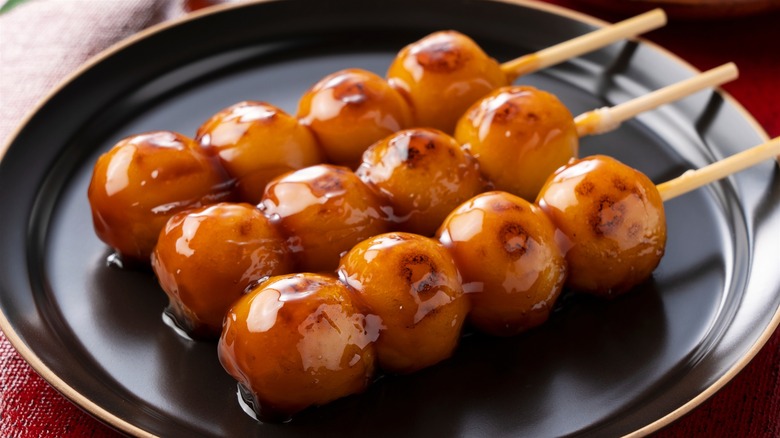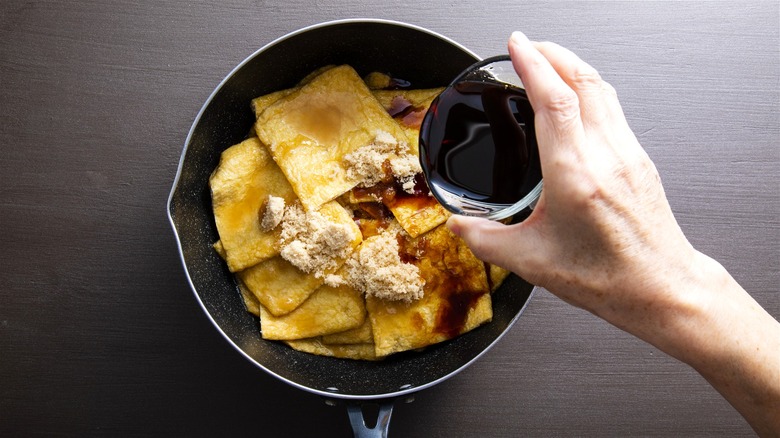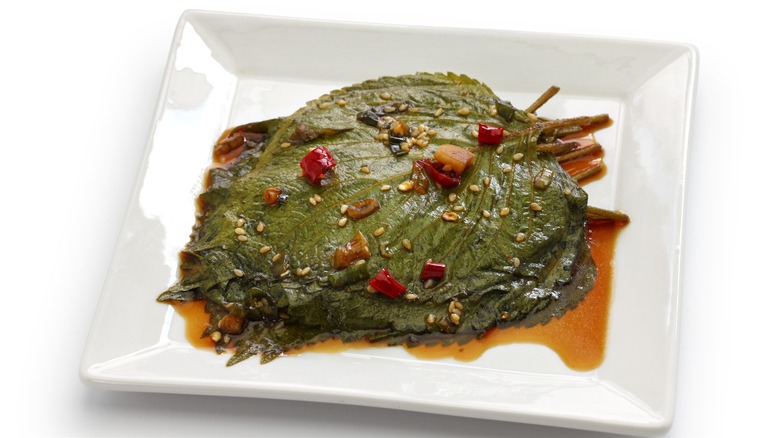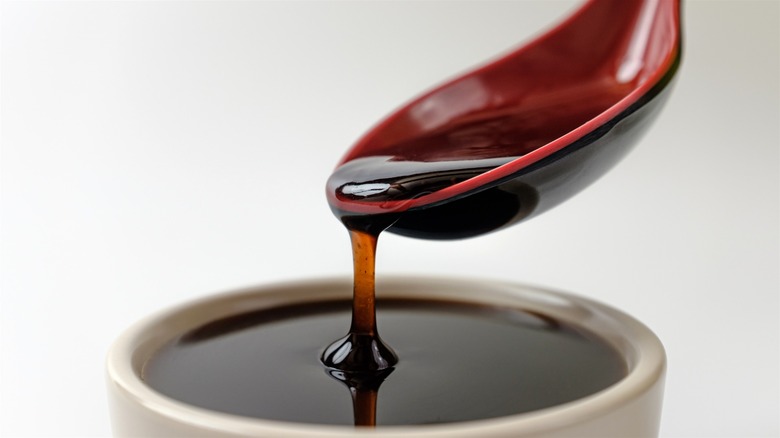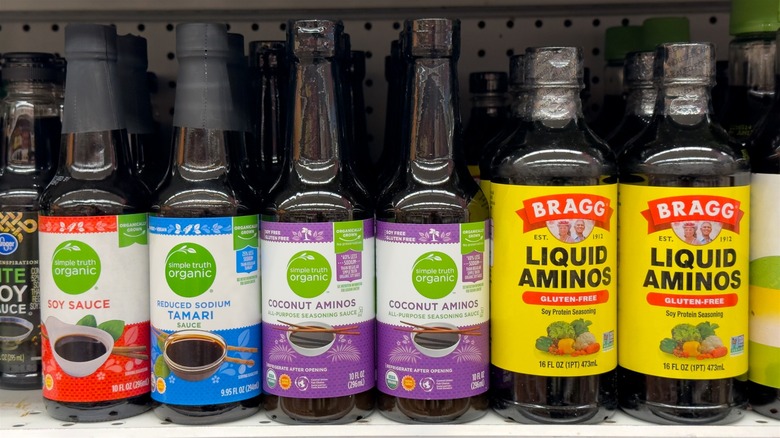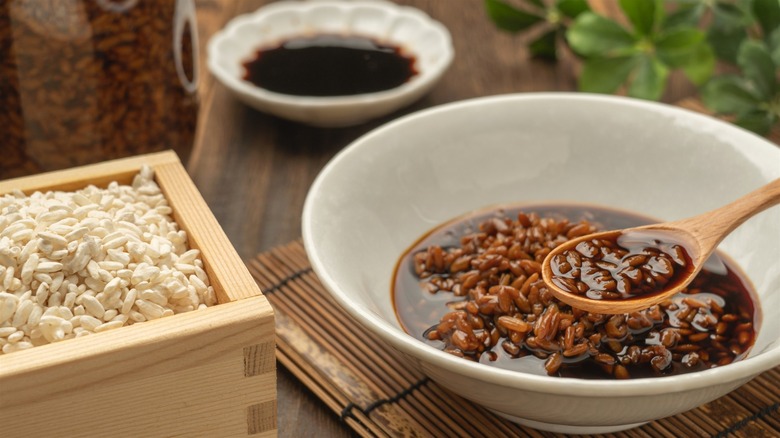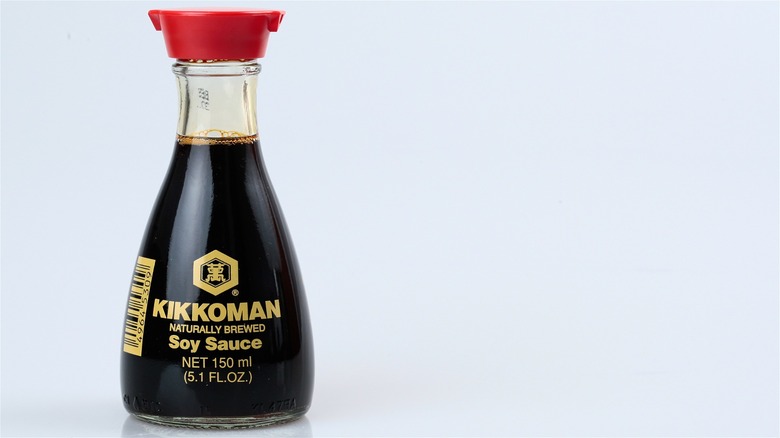17 Facts You Need To Know About Soy Sauce
Few of us ever really question the history and purpose of everyday pantry staples. For example, have you ever wondered about the origins of your soy sauce or how it's crafted? Even if you do know something here and there — that it's a fermented product capable of more than just accompanying sushi, for instance — there is still plenty to learn about this versatile, ancient seasoning.
Despite its global ubiquity in modern pantries, for most of its existence, soy sauce was a labor-intensive, slowly fermented product that wasn't accessible to just anyone. Beginning as a Chinese fish paste and evolving in Buddhist Japan, it was a luxury for both local populations and intrigued Westerners who dubbed it "ketchup." The industrial age changed the game, ushering in mass-produced, at times entirely synthetic soy sauce, altering its status from artisanal to commonplace. So, if you're eager to trace its cross-cultural journey and intrigued by its diverse culinary applications, read on to discover fascinating soy sauce facts and techniques.
This ancient seasoning has more than one predecessor
Like many fermented foods, soy sauce is rooted in the distant past. Today, some people might associate the umami-packed liquid with Japan, but the ancient ancestor of soy sauce actually originated in China. A preserve known as jan was initially made from various pickled plants and meat, but by the 2nd century B.C., it became largely plant-based, using a mixture of soybeans, rice, and wheat. Centuries later, this fermented paste made its way to Japan alongside the spread of Buddhism.
Renamed hishio, it became a go-to condiment of the primarily vegetarian Buddhist diet for almost a millennium. Eventually, the dark brown, semisolid concoction evolved to become miso. Then, the excess liquid that formed during its fermentation was recognized as a delicious seasoning in itself. Thus, the unintentional byproduct of miso-making rose to fame as tamari, eventually evolving into shoyu. By the 17th century, a new variety of shoyu, closest to what we know today, was developed from soybeans and roasted crushed wheat.
Buddhists spread it as a vegetarian alternative to fish sauce
Modern vegans know how important it is to stock your pantry with spices and seasonings to transform plants from dull to delectable, and soy sauce is a potent tool in this transformation. The Buddhist monks of yore thought along the same lines. As one of the core precepts of Buddhism is to abstain from taking life, many of its followers are vegetarian. Fortunately, these limitations sparked culinary ingenuity that plant-based eaters benefit from to this day. Where would they be if the Buddhist monks hadn't invented seitan? Or, more importantly, where would all of us be had they not traveled around, spreading not just their religious teachings but their soy-based ways?
Abstaining from killing living beings meant that fermented meat-based sauce was a no-go. A vegetarian alternative was required to season austere Buddhist meals, so soy sauce production became a common monastic activity. This tradition has been passed down through generations and remains to this day.
Soy sauce used to be a luxury item
The rapid industrialization and globalization of the food system over the last few centuries transformed things like coffee and spices from the high-class delicacies they once were into everyday staples. Soy sauce joined their ranks sometime in the first half of the 20th century. While it's understandable that the journey from Asia to Europe significantly increased the prices of soy sauce in, say, the 17th century, it's poignant that for most of its existence, it was also a distant dream for the locals, struggling to afford this simple pleasure.
This injustice was due to soy sauce's laborious and time-consuming production process and lower yields compared to miso, which was the go-to condiment in the predominantly peasant population of premodern Japan. The post-WWII period brought on innovations in soy sauce production, which shortened the fermentation period and cheapened the source material. Thus, industrialized soy sauce was finally ready to conquer the world as an affordable staple.
There is more than one type of soy sauce
If you're ready to branch out from that Kikkoman bottle, there are over a dozen other soy sauce varieties, distinguished by country of origin, production process, and culinary applications (though there might be some crossover).
Let's start with Japanese dark soy sauce, koikuchi shoyu — the readily available all-purpose variety for any recipe that calls for unspecified soy sauce. It may seem counterintuitive, but you can use koikuchi and Chinese light soy sauce interchangeably. The latter has a hint of sweetness thanks to added sugar or molasses. Filipino toyo is very similar, albeit wheat-free and more potent. Indonesian kecap manis takes it even further with aromatics. Meanwhile, shiro shoyu is made in a slightly different process, with extra wheat, giving it a golden color and gentler flavor. Like the tangy, sweet usukuchi shoyu (Japanese light soy sauce), it is best reserved for light-colored dishes. Traditional Korean soy sauce, like joseon ganjang is made from fermented soybeans, but jin ganjang is blended with the cheaper, chemically produced variety.
Soy sauce is related to ketchup
Sold and beloved all over the world, ketchup and soy sauce have more in common than their ubiquity. If you know your ketchup, you'll guess that the two are distant relatives. What we know now as a thick, vinegary tomato sauce started out as kêtsiap, which translates to "pickled fish brine" in the Amoy dialect of Chinese. Soy sauce, too, was preceded by a Chinese fish sauce. Both evolved to become entirely plant-based.
The two have been historically confused with each other. The term "kêtsiap" likely made its way to the Dutch East Indies, where it was applied to Indonesian-style soy sauce, known today as kecap manis. When it was imported to the West between the 17th and 19th centuries, it was referred to as either kechup (and similar-sounding words) or simply soy. Meanwhile, Western cooks tried to recreate Asian fish-based soy sauces with what was available. Thus, mushroom ketchup was born, giving way to the tomato version in the 1800s.
Traditionally brewed soy sauce contains alcohol
A traditionally produced, all-natural soy sauce contains only a handful of ingredients you wouldn't need Google's help to recognize: Soybeans, salt, wheat, and water. But if you look closer, you'll see that this soy sauce also contains alcohol. It's not something added on purpose, but rather a natural byproduct of fermentation. When a mash of soybeans, crushed wheat, koji mold, and brine are cultured, a yeast called Zygosaccharomyces rouxii gets to work, producing the sauce's signature flavor — and alcohol.
The good news is, you probably don't have to worry about it. For one, alcohol content rarely exceeds 1-3% (anything above 0.5% must be disclosed on the packaging), so it's easy to choose an alcohol-free option if needed. Plus, alcohol evaporates during cooking — something those keen on making penne alla vodka are well aware of. However, it doesn't disappear altogether, so if you're avoiding alcohol at all costs, it might be a better idea to go for liquid aminos or an all-purpose seasoning.
Commercial soy sauce is often not fermented
The greatest benefit of industrializing soy sauce production was making it budget-friendly and accessible to people worldwide, but such progress always comes at a cost. In this case, the cost is fermentation, and all the deep, vibrant flavors that go with it — not to mention the health benefits associated with fermented foods.
In contrast with traditional soy sauce, the cheap "chemical" alternative is made not from whole soybeans but defatted soy meal. Where traditional soy sauce can take weeks and months to ferment, producing the artificial version can take as little as a day. First, soy protein is treated with hydrochloric acid, subjected to prolonged heating, then neutralized with soda ash or lye and filtered to produce a liquid that has little in common with soy sauce — yet. Adding caramel coloring makes up for the lack of browning produced by fermentation, and additives like corn syrup and salt give it flavor. However, a semi-chemical soy sauce will include some of the fermented stuff for an improved flavor profile.
Soy sauce towns preserve the traditional methods
It took many centuries for soy sauce to migrate from a handmade seasoning made by Buddhist monks and peasants to a mass-produced condiment sold in supermarkets worldwide. Inevitably, this transition has affected the way soy sauce is produced, as well as the lives of those who make it. However, some small-town manufacturers persevere and remain rooted in tradition despite the industrial shift.
One such place is Lezhi, a Sichuan town, once home to a large soy sauce factory that ceased operations in 1999, it's now a site of old-school small-scale manufacturing that doesn't shy away from fermenting fresh soybeans for months, outside, in large earthenware pots. Another example is Hishio-no-sato, Japan's former soy sauce capital, once brimming with 400 manufacturers. Although only 20 soy sauce makers remain, the town still produces soy sauce and welcomes visitors to witness their craft. Finally, there's the Vietnamese village famous for its eponymous Ban soy sauce, which has spurred a tourist industry built around witnessing the traditional production process.
Soy sauce is good for more than sushi
While there's nothing wrong with limiting your relationship with soy sauce to sushi, those willing to take this relationship to the next level will be rewarded beyond their greatest expectations. The deep, dark color and rich umami of soy sauce make an excellent all-purpose flavor bomb, and once you get into the groove, you'll want to add it to everything.
Name a savory dish, and we'll tell you whether it's better with soy sauce. A stew? Surely! It will blend in seamlessly, enhancing the color while offsetting the flavors. Marinated tofu? Of course! Your proteins deserve to be coated in that rich umami. Compound butter? Your brunch guests will talk about that one for weeks. Literally any soup? Definitely better with soy sauce. It can also elevate boxed stuffing mix, instant ramen, and everything in between. It can even make bolognese taste meatier!
It's a key ingredient in Asian soups and stocks
The flavoring powers of soy sauce go far beyond its native cuisines, but they wouldn't be the same without it. Dishes like shoyu ramen wouldn't even exist if it wasn't for tare — a concentrated flavor-packed sauce used to make ramen stock. This isn't to say that the stock isn't flavorful on its own, as a mixture of meat and aromatic vegetables like alliums, carrots, and ginger can hardly produce a bland result, but tare steals the show. Would you expect less from a mixture of soy sauce, sake, mirin, salt, and sugar? We didn't think so. Additionally, you can find commercial soup bases that mix soy sauce and other umami-packed ingredients, like dashi (fish and/or kelp soup stock).
Chinese master stock is at the other end of the spectrum. This soy sauce-based braising elixir's akin to a perpetual stew — it's all about infusing and absorbing flavors by straining and reusing the cooking liquid, each iteration adding layers of rich, savory, and sweet complexity.
It has a place in the world of desserts
If you thought soy sauce belonged exclusively to the savory realm, think again. The more you learn about it, and the more you experiment, the clearer it becomes: Soy sauce simply refuses to be put in one box. And that's why you should start adding it to desserts.
The Japanese have been onto this forever. Sweet soy sauce glaze is what makes mitarashi dango, a traditional dessert of skewered chewy rice flour balls, so addictive. But if you'd rather tread more familiar territory, start mixing soy sauce into your go-to chocolatey desserts. A rule of thumb is substituting each teaspoon of kosher salt with twice as much soy sauce in the batter — your brownies will thank you. A couple of tablespoons whipped into a chocolate buttercream frosting will have a more dramatic effect. Finally, soy sauce is excellent in caramels, whether dairy- or plant-based. Drizzled over ice cream or pancakes, it elevates one-note dishes like no other.
There are easy hacks to balance soy sauce flavor
The flavor of soy sauce, while beautifully rich and complex, can sometimes be overwhelming or simply too salty. If you're trying to lower your sodium intake, the most obvious solution to tone down the saltiness of soy sauce is diluting it with water. This tip is also useful for marinades, giving you better flavor control.
Regardless of skill level, most cooks are guilty of occasionally overseasoning their food. With soy sauce, it's all too easy, especially if you pour it out directly out of the bottle. When this happens to you, don't fret. There's a simple way to reduce soy sauce's richness: Counteract it with something acidic, such as rice vinegar or citrus juice. This adds a very welcome refreshing note. Using a sweetener, like a dash of sugar or a light drizzle of agave, can produce similar results, offsetting the saltiness while neutralizing any bitterness.
Soy sauce can be used in pickling
As a fermented product itself, soy sauce is a natural addition to other preserves. With its potent flavor punch and savory allure, it's often used to cure egg yolks, transforming them into umami bombs — but there are also plenty of vegan-friendly soy sauce pickle options.
Introducing shoyuzuke. This traditional Japanese pickling technique infuses vegetables with a flavorful brine of soy sauce, rice vinegar, and sugar, with dashi, mirin, ginger, and sesame as guest stars. Together, they give a distinctively savory and slightly sweet taste profile. Shoyuzuke technically count as fridge pickles, and they couldn't be easier to make. Whether you're working with a sturdy vegetable like daikon, fresh shiitake mushrooms, or plain old cucumbers, all you'll need is to douse them in that brine, press, and refrigerate. They'll be ready in a few hours. Taste as you go, and drain the brine if you feel like the saltiness is overpowering.
Many other sauces are based on it
While soy sauce is a self-sufficient condiment that's good on its own, it would be a culinary crime not to use its full-bodied flavor as a base for other, more complex sauces. Here are a few of them.
Toyomansi sauce is a mainstay of Filipino cuisine, used both as a marinade and a dipping sauce. It's a semi-chunky mix of minced garlic and chili pepper swimming in a sea of soy sauce, calamansi juice, and sugar. No satay would be complete without a Thai or Indonesian peanut sauce, with freshly ground roasted peanuts with soy sauce and spices. Tonkatsu sauce, made with ketchup, Worcestershire sauce, and mirin, is a barbecue sauce with a Japanese flair. Ponzu, combining citrus juice, rice vinegar, mirin, and sea flavors, is a vibrantly acidic dipping sauce. There's more where that came from: Soy sauce's second historical home built unagi and tare sauce varieties on its foundation, forever changing the way we eat.
There are easy ways to substitute soy sauce
Whether you're gluten-intolerant, allergic to soy, or resolutely avoiding alcohol, there are plenty of ways to substitute soy sauce in your home cooking. Tamari is a fermented, naturally gluten-free alternative because it's a miso byproduct, so no wheat is involved in its production. But those with celiac disease should seek out certified gluten-free tamari or liquid aminos. The latter is that "chemical" soy sauce made from hydrolyzed soy protein. If your soy-free cooking needs a fermented flavor kick then coconut aminos, an aged juice of coconut blossoms, can always come to the rescue. Though it doesn't taste like coconut, it's still on the sweeter side.
If a recipe calls for soy sauce, and you're out, you can swap it with Worcestershire, but remember to dilute it first. For every four tablespoons of soy sauce, use one tablespoon of Worcestershire and three tablespoons of water. In a pinch, miso, salt, and tomato paste can all work.
You can ferment your own soy sauce
Whether you're a home fermentation enthusiast or are simply worried about never having tasted the real deal, you can always try your hand at fermenting your own soy sauce. Perhaps it's not the most obvious condiment to try making from scratch, but it's well worth the effort, if only for the bragging rights.
Using traditional brewing methods, you can start by making moromi — a mash of cooked soybeans, roasted wheat, and koji, a mold that kick-starts fermentation. Allow this mixture to ferment for several days in a warm, humid environment. Transfer the fermented mixture to a brine solution and let it mature for several months to develop its rich flavor and color. Regularly monitor and stir your concoction to ensure proper fermentation. Once the soy sauce has achieved its desired depth and complexity, strain and bottle it. Voila! You've got the essence of your patience, dedication, and craftsmanship, with plenty of umami to boot.
Its typical packaging has a purpose
Most of us take packaging design for granted and pay little attention to it, yet its story is often fascinating. For example, the evolution of soy sauce packets was a messy affair. While they seem to have been popularized in the 1960s by food packaging company Kari-Out, it certainly didn't invent them. One of the original patents from the 1950s envisioned a dispensing container that would be leak-free, but alas, very little has been done to improve those single-use packets.
In case you've ever wondered why soy sauce bottles have two spouts, they're there to improve your pouring experience! Placing your finger on one helps stifle the flow a bit, giving you better control when applied in small, local doses. Conversely, leaving the spout uncovered creates a free flow of air inside the bottle, increasing the speed and intensity of the stream, which is perfect for cooking. The more you know!
